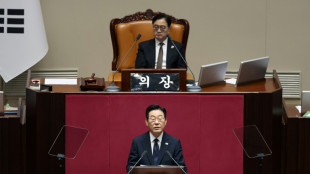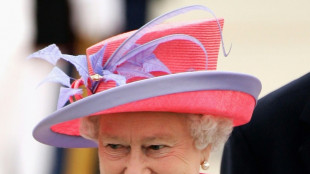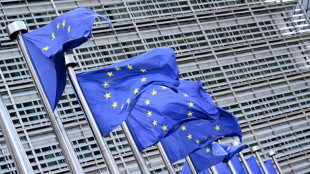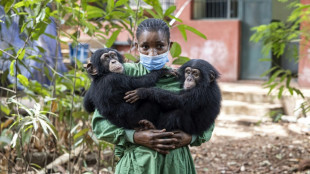
-
 Jamie Melham on Half Yours only second woman to win Melbourne Cup
Jamie Melham on Half Yours only second woman to win Melbourne Cup
-
Myanmar scam hub sweep triggers fraudster recruitment rush

-
 Biggest emitter, record renewables: China's climate scorecard
Biggest emitter, record renewables: China's climate scorecard
-
Floods strand people on roofs as typhoon pounds Philippines

-
 Asian markets swing as trades eye tech rally, US rate outlook
Asian markets swing as trades eye tech rally, US rate outlook
-
South Korea to triple AI spending, boost defence budget

-
 Trott to leave as Afghanistan coach after T20 World Cup
Trott to leave as Afghanistan coach after T20 World Cup
-
Late queen's fashion to go on show at Buckingham Palace

-
 In Morocco, exiled Afghan women footballers find hope on the pitch
In Morocco, exiled Afghan women footballers find hope on the pitch
-
EU scrambles to seal climate deal ahead of COP30

-
 New Yorkers expected to pick leftist Mamdani in stunning election
New Yorkers expected to pick leftist Mamdani in stunning election
-
Pining for Pinochet: how crime fanned nostalgia for Chile's dictator

-
 Why an Amazon chef said no to a vegan dinner for Prince William event
Why an Amazon chef said no to a vegan dinner for Prince William event
-
Cement maker Lafarge on trial in France on charges of funding jihadists

-
 Worker dies after medieval tower partly collapses in Rome
Worker dies after medieval tower partly collapses in Rome
-
Run-machine Labuschagne in form of his life ahead of Ashes

-
 Prince William plays football, volleyball in Rio on climate trip
Prince William plays football, volleyball in Rio on climate trip
-
Jamaicans mobilize aid in aftermath of Melissa's wreckage

-
 Starbucks cedes China control to Boyu Capital
Starbucks cedes China control to Boyu Capital
-
Worker rescued after medieval tower partly collapses in Rome

-
 'Wild at Heart' actress Diane Ladd dies at 89
'Wild at Heart' actress Diane Ladd dies at 89
-
Xhaka lifts Sunderland into fourth after Everton draw

-
 Brazil records biggest annual fall in emissions in 15 years: report
Brazil records biggest annual fall in emissions in 15 years: report
-
Victor Conte, mastermind of BALCO doping scandal, dead at 75: company

-
 Trial opens in 1st US civil case on 2019 Boeing MAX crash
Trial opens in 1st US civil case on 2019 Boeing MAX crash
-
Mixed day for global stocks as market digests latest AI deals

-
 Barrett brothers out of All Blacks' clash with Scotland
Barrett brothers out of All Blacks' clash with Scotland
-
Medieval tower partially collapses in Rome, trapping worker

-
 Arsenal's Arteta says injured Gyokeres out of Slavia Prague tie
Arsenal's Arteta says injured Gyokeres out of Slavia Prague tie
-
Alonso says 'quality' Wirtz helped get him Real Madrid job

-
 US Fed's Cook warns inflation to stay 'elevated' next year
US Fed's Cook warns inflation to stay 'elevated' next year
-
Blue heaven: huge crowds salute Los Angeles Dodgers in victory parade

-
 Dutch centrist Jetten clinches election win: final tally
Dutch centrist Jetten clinches election win: final tally
-
Mamdani extends olive branch to anxious NY business community

-
 Sierra Leone chimpanzee sanctuary reopens after deforestation protest
Sierra Leone chimpanzee sanctuary reopens after deforestation protest
-
Shein bans sex dolls after France outrage over 'childlike' ones

-
 England full-back Steward doubtful for Autumn rugby clash with Fiji
England full-back Steward doubtful for Autumn rugby clash with Fiji
-
Bayern know how to 'hurt' PSG, says Neuer

-
 Rybakina downs Swiatek to reach WTA Finals last four
Rybakina downs Swiatek to reach WTA Finals last four
-
Ex-France international Ben Yedder to stand trial on rape charges

-
 Djokovic confirmed for ATP Finals, says Italian federation boss
Djokovic confirmed for ATP Finals, says Italian federation boss
-
Trent should be remembered for 'great' Liverpool moments, says Slot

-
 Stock markets diverge despite boost from AI deals
Stock markets diverge despite boost from AI deals
-
Prince William awed by Rio on climate-focused trip to Brazil

-
 Violence in Sudan's El-Fasher could be war crimes, says top court
Violence in Sudan's El-Fasher could be war crimes, says top court
-
Rybakina downs Swiatek in WTA Finals

-
 Turkey, Muslim allies say Palestinian self-rule key to Gaza future
Turkey, Muslim allies say Palestinian self-rule key to Gaza future
-
Tens of thousands shelter as typhoon slams into Philippines

-
 Stock markets rise as tech sector buoyed by fresh AI deal
Stock markets rise as tech sector buoyed by fresh AI deal
-
Vitinha says PSG-Bayern Champions League clash will show who's 'best'


Nobel scientist uncovered tiny genetic switches with big potential
Harvard geneticist Gary Ruvkun vividly remembers the late-night phone call with his longtime friend and now 2024 Nobel Prize in Medicine co-laureate Victor Ambros, when they made their groundbreaking discovery of genetic switches that exist across the tree of life.
It was the early 1990s. The pair, who had met a decade earlier and bonded over their fascination with an obscure species of roundworm, were exchanging datapoints at 11 pm -- one of the rare moments Ambros could steal away from tending to his newborn baby.
"It just fit together like puzzle pieces," Ruvkun told AFP in an interview from his home in a Boston suburb, shortly after learning of the award on Monday. "It was a eureka moment."
What they had uncovered was microRNA: tiny genetic molecules that act as key regulators of development in animals and plants, and hold the promise of breakthroughs in treating a wide range of diseases in the years ahead.
Although these molecules are only 22 "letters" long -- compared to the thousands of lines of code in regular protein-coding genes -- their small size belies their critical role as molecular gatekeepers.
"They turn off target genes," Ruvkun explained.
"It's a little bit like how astronomy starts with looking at the visible spectrum, and then people thought 'If we look with X rays, we can see much higher energy events,'" he added.
"We were looking at genetics at much smaller scales than it had been looked at before."
- Dismissed at first -
Their discovery had its roots in early investigations into C. elegans, a one-millimeter-long roundworm.
Ambros and Ruvkun were intrigued by the interplay between two genes that seemed to disrupt the worm's normal development -- causing them either to stay in a juvenile state or acquire adult features prematurely.
The genetic information contained in all our cells flows from DNA to messenger RNA (mRNA) through a process called transcription, and then on to the cellular machinery where it provides instructions on which proteins to create.
It's through this process, understood since the mid-20th century, that cells become specialized and carry out different functions.
But Ambros and Ruvkun, who began their work in the same lab before moving to different institutions, discovered a fundamentally new pathway for regulating gene activity through microRNAs, which control gene expression after transcription.
They published their findings in back-to-back papers in Cell in 1993, but at first, the discovery was dismissed as an esoteric detail, likely irrelevant to mammals.
"We were considered an oddity in the world of developmental biology," Ruvkun recalled. Even he had little idea their work would one day be celebrated by the wider scientific community.
That all changed in 2000 when Ruvkun's lab discovered another microRNA that was present throughout the tree of life -- from roundworms to mollusks, chickens, and humans.
- 'Celebrating like crazy' -
At the time, the human genome was still being mapped, but the portion that was complete was available to researchers.
"I think it was probably one-third done, and I could already see (the new microRNA) in that one-third of the human genome," said Ruvkun. "That was a surprise!"
Since then, the microRNA field has exploded, with more than 170,000 citations currently listed in biomedical literature.
More than 1,000 microRNAs have been identified in human DNA, and some are already being used to better understand tumor types and develop treatments for people with chronic lymphocytic leukemia.
Trials are also underway to develop microRNAs as treatments for heart disease.
On the morning of their Nobel win, the two old friends "Facetimed and high-fived," Ruvkun said. "It's magnificent, and we're going to be celebrating like crazy."
V.Said--SF-PST




